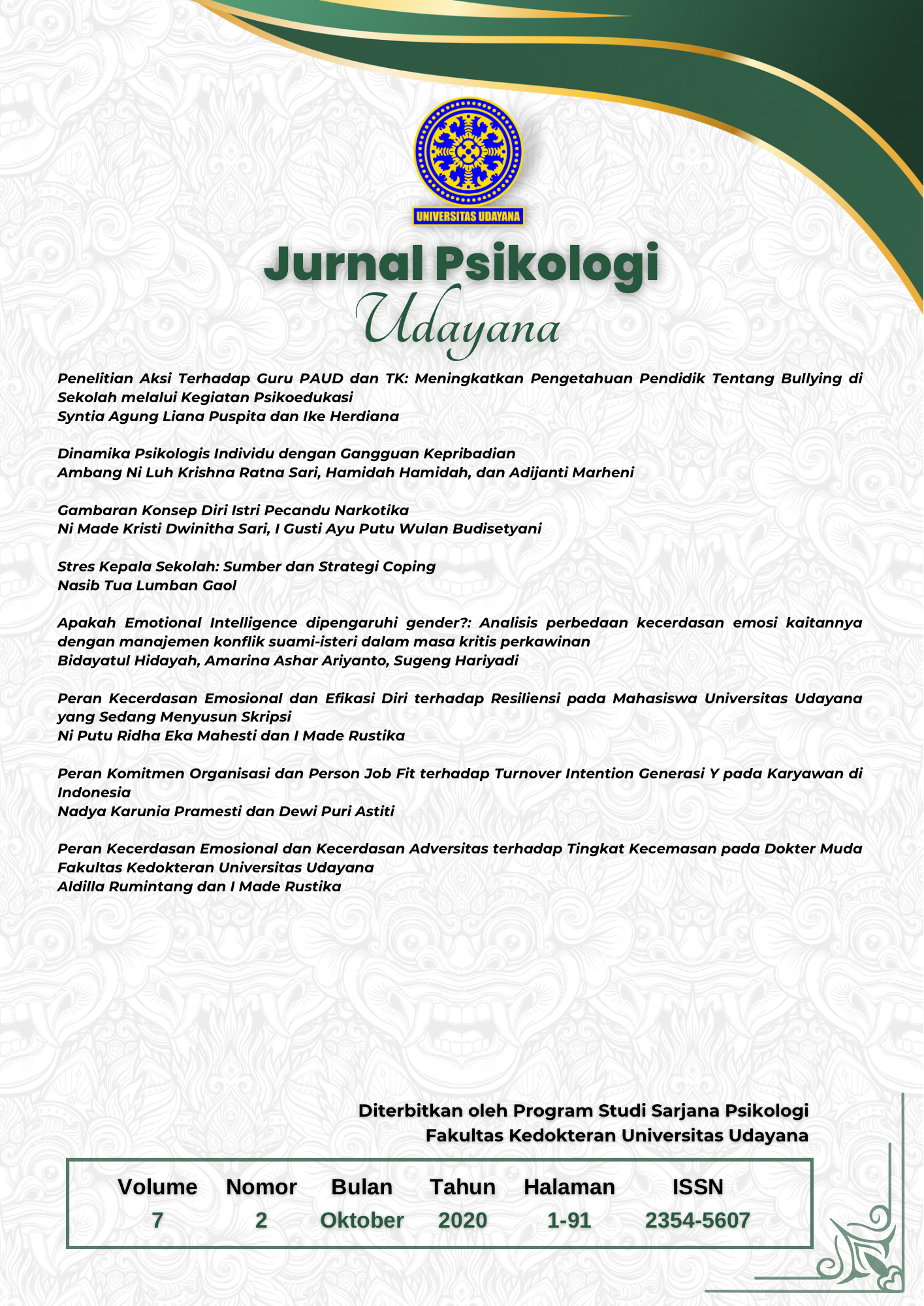Dinamika Psikologis Individu dengan Gangguan Kepribadian Ambang
Abstract
Abstrak
Gangguan kepribadian ambang merupakan salah satu gangguan kepribadian yang banyak ditemui dalam praktik layanan psikiatri maupun psikologi. Penelitian ini bertujuan untuk memaparkan dinamika psikologis individu dengan kepribadian ambang berdasarkan hasil asesmen yang akan dilakukan. Subjek dalam penelitian ini merupakan seorang laki-laki usia dewasa awal yaitu 24 tahun yang menunjukkan gejala-gejala dari gangguan kepribadian ambang. Metode penelitian yang digunakan adalah kualitatif dengan pendekatan studi kasus. Pengambilan data dilakukan melalui asesmen psikologi mencakup wawancara, observasi, dan pemberian tes psikologi yaitu tes grafis (BAUM, DAP, dan HTP), SPM (Standart Progressive Matrices), SSCT (Sack’s Sentence Completion Test), dan Drawing Completion Test (DCT). Hasil penelitian menunjukkan bahwa subjek memiliki aspek-aspek kepribadian seperti ketidakstabilan emosi, kontrol yang rendah terhadap dorongan, dan kebutuhan untuk tergantung pada orang lain. Subjek memiliki pengalaman traumatis seperti kekerasan dan perpisahan dini dengan figur orangtua, disfungsi keluarga serta faktor lingkungan tidak suportif. Interaksi antara kedua kondisi tersebut menggambarkan dinamika psikologis dari gejala-gejala gangguan kepribadian ambang pada subjek.
Kata kunci : Dewasa awal, gangguan kepribadian ambang, pengalaman traumatis.
Abstract
Borderline personality disorder is one of the personality disorders that is widely encountered in psychiatric and psychological practices. This research aims to explore the psychological dynamics of individuals with borderline personality disorder based on the results of the assessment. The subject in this study is a 24-years-old man that showed the symptoms of borderline personality disorder. The research method used is qualitative with a case study approach. Data were collected through psychological assessment including interviews, observations, and some psychological tests such as graphic tests (BAUM, DAP, and HTP), SPM (Standart Progressive Matrices), SSCT (Sack's Sentence Completion Test), and Drawing Completion Test (DCT). The results showed that the subject had personality aspects such as emotional instability, low control of psychological drive, and the need to depend on others. Subjects have traumatic experiences such as abuse and early separation with parental figures, family dysfunction as well as unsupportive environmental factors. Interactions between these two conditions illustrate the psychological dynamics of the symptoms of borderline personality disorders addresses by subject.
Keywords : Borderline personality disorder, traumatic experiences, young adulthood.
Downloads
References
American Psychiatric Association. (2013). Diagnostic and statistical manual of mental disorder: DSM-5TM (5th Edition). American Psychiatric Publishing.
Arens, E. A., Stopsack, M., Spitzer, C., Appel, K., Dudeck, M., Völzke, H., ... & Barnow, S. (2013). Borderline personality disorder in four different age groups: A cross-sectional study of community residents in Germany. Journal of personality disorders, 27(2), 196-207. https://doi.org/10.1521/pedi_2013_27_072
Bateman, A. W., & Krawitz, R. (2013). Borderline personality disorder: an evidence-based guide for generalist mental health professionals. Oxford University Press.
Biskin, R.S., & Paris, J. (2012). Management of borderline personality disorder. Canadian Medical Association Journal, 184(17), 1897-1902. https://doi.org/10.1503/cmaj.112055
Cailhol, L., Giqcuel, L., & Raynaud, J. (2012). Borderline personality disorder. In Rey JM (ed), IACAPAP e-Textbook of Child and Adolescent Mental Health. Geneva: International Association for Child and Adolescent Psychiatry and Allied Professions.
Carpenter, R. W., & Trull, T. J. (2013). Components of emotion dysregulation in borderline personality disorder: A review. Current Psychiatry Reports, 15(1), 335. https://doi.org/10.1007/s11920-012-0335-2
Drapeau, M., Perry, J.C., Korner, A. (2012). Interpersonal pattern in borderline personality disorder. Journal of Personality Disorder, 26(4), 583-592. https://doi.org/10.1521/pedi.2012.26.4.583
Ibrahim, J., Cosgrave, N., & Woolgar, M. (2017). Childhood maltreatment and its link to borderline personality disorder features in children: A systematic review approach. Clinical Child Psychology and Psychiatry, 00(0), 1-20. https://doi.org/10.1177/1359104517712778
Kaess, M., Brunner, R., & Chanen, A.M. (2014). Borderline personality disorder in adolescence. Pediatrics, 134(4), 782-793. https://doi.org/10.1542/peds.2013-3677
Kingdon, D.G., Ashcroft, K., Bhandari, B., Gleeson, S., Warikoo, N., Symons, M., ... & Mason, A. (2010). Schizophrenia and borderline personality disorder: similarities and differences in the experience of auditory hallucinations, paranoia, and childhood trauma. The Journal of Nervous and Mental Disease, 198(6), 399-403. 10.1097/NMD.0b013e3181e08c27
Kulacaoglu, F., & Kose, S. (2018). Borderline personality disorder (BPD): in the midst of vulnerability, chaos, and Awe. Brain Sciences, 8(201), 1-11. https://doi.org/10.3390/brainsci8110201
Livesley, W. J. (2017). Integrated modular treatment for borderline personality disorder: A practical guide to combining effective treatment methods. Cambridge University Press.
Sansone, R. A., Sellbom, M., & Songer, D. A. (2016). Criminal Behavior and Borderline Personality: Correlations Among Four Measures. Innovations in Clinical Neuroscience, 13(7-8), 14-16.
Schultz, H. E., & Hong, V. (2017). Psychosis in borderline personality disorder: how assessment and treatment differs from psychotic disorder: evaluate the tone and timing of hallucinations in suspected bpd, emphasize psychotherapy. Current Psychiatry, 16(4), 24-29.
Stewart, N. A., Tough, W. M., & Chambers, G. N. (2019). Psychological interventions for individuals with a diagnosis of borderline personality disorder in forensic settings: A systematic review. The Journal of Forensic Psychiatry & Psychology, 30(5), 744-793. https://doi.org/10.1080/14789949.2019.1637917
Videler, A. C., Hutsebaut, J., Schulkens, J. E., Sobczak, S., & Van Alphen, S. P. (2019). A life span perspective on borderline personality disorder. Current Psychiatry Reports, 21(7), 51. https://doi.org/10.1007/s11920-019-1040-1
Wibhowo, C., So, K.A.D., Siek., & Santoso, J.G. (2019). Trauma masa anak, hubungan romantis, dan kepribadian ambang. Jurnal Psikologi, 46(1), 63-71.
Winsper, C. (2017). The aetiology of borderline personality disorder (BPD): Contemporary theories and putative mechanism. Current Opinion in Psychology, 1-18. https://doi.org/10.1016/j.copsyc.2017.10.005

This work is licensed under a Creative Commons Attribution-ShareAlike 4.0 International License.
Authors who publish with this journal agree to the following terms:
- Authors retain copyright and grant the journal right of first publication with the work simultaneously licensed under a Creative Commons Attribution-ShareAlike 4.0 International License that allows others to share the work with an acknowledgement of the works authorship and initial publication in this journal.
- Authors are able to enter into separate, additional contractual arrangements for the non-exclusive distribution of the journals published version of the work (e.g., post it to an institutional repository or publish it in a book), with an acknowledgement of its initial publication in this journal.
- Authors are permitted and encouraged to post their work online (e.g., in institutional repositories or on their website) prior to and during the submission process, as it can lead to productive exchanges, as well as earlier and greater citation of published work (See The Effect of Open Access).













